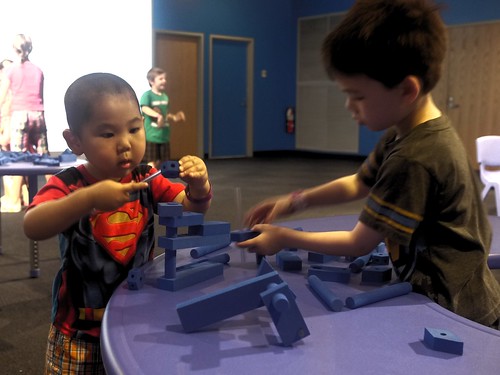 |
| Cousins playing at the Carnegie Science Center Blue exhibit |
This month was marked by my family visiting. My parents came for a month, and my sisters and nephew came for a week.
The highlight, of course, was grandparents spending time with a new grandchild. The other highlight was the cousins recurring time with each other. As T and J get older, their interaction becomes richer as both grow in their abilities to deal with other people.
 |
| Grandma and grandson at the Carnegie Museum of Natural History |
AY has been notable in her responsiveness. As she is the second, we cannot help making comparisons to the only baseline we know. At this time, T was in the midst of colic. In comparison, AY is very responsive, trying out a range of facial expressions when we are talking to her, and vocalizing in call and response fashion. We are also entertained by her kicking and reaching out to things.
T is still the very good big brother. He likes to tell everyone that AY talks, sleeps, poops, and cries. He also still read and talk to his little sister, and helps with bath and diaper changing time. However, the novelty is wearing off, and he is not always as excited to help out as he was.
We have noticed that while T is more outgoing and social (talks and plays at pre-school, tells short stories at home), he is regressing in other areas. We have noted that he used to have a relatively long attention span, focusing on one activity longer than others his age before switching. But it has gotten shorter. This is observable when reading books or when making things (Lego or woodworking). Another not so good trend is that he is becoming more self-conscious of his limitations. Things that he used to try (and do fairly well) are now approached with a statement of "I can't do it". While he is still a very well behaved and happy child, we do see some of the not so welcome traits that are probably quite prevalent in preschoolers, some that we are hoping that he skips the worst of. Part of this may come with paying attention more to others his age, and taking on their habits, playing, and capabilities. Some of these are fairly innocuous, like growing a liking for superheroes (and yes, there is one kid in his class that bears most of the responsibility for teaching everyone about superheroes) and the fact that he picks up pop culture (everyone knows Frozen, but Star Wars, TMNT, and others are common. I consider it part of my duty to try to get a step ahead of what he learns from his classmates :-) ) But he has also picked up increased instances of the use of the word 'no' and occasionally trying out tantrums to try to get his way. At this point, we are still pretty successful at working our way around 'no' through humor, and we're trying to teach him that tantrums don't work nearly as well as other things (like reminding him of some of the things we can do with him because we are not worried about tantrums at all)
We have noticed that while T is more outgoing and social (talks and plays at pre-school, tells short stories at home), he is regressing in other areas. We have noted that he used to have a relatively long attention span, focusing on one activity longer than others his age before switching. But it has gotten shorter. This is observable when reading books or when making things (Lego or woodworking). Another not so good trend is that he is becoming more self-conscious of his limitations. Things that he used to try (and do fairly well) are now approached with a statement of "I can't do it". While he is still a very well behaved and happy child, we do see some of the not so welcome traits that are probably quite prevalent in preschoolers, some that we are hoping that he skips the worst of. Part of this may come with paying attention more to others his age, and taking on their habits, playing, and capabilities. Some of these are fairly innocuous, like growing a liking for superheroes (and yes, there is one kid in his class that bears most of the responsibility for teaching everyone about superheroes) and the fact that he picks up pop culture (everyone knows Frozen, but Star Wars, TMNT, and others are common. I consider it part of my duty to try to get a step ahead of what he learns from his classmates :-) ) But he has also picked up increased instances of the use of the word 'no' and occasionally trying out tantrums to try to get his way. At this point, we are still pretty successful at working our way around 'no' through humor, and we're trying to teach him that tantrums don't work nearly as well as other things (like reminding him of some of the things we can do with him because we are not worried about tantrums at all)
 |
| Siblings! |
One more month of summer, then both academic parents go back into a full work schedule, but for now, we are thankful that a relatively relaxed summer lets us have this level of interaction with our kids.




